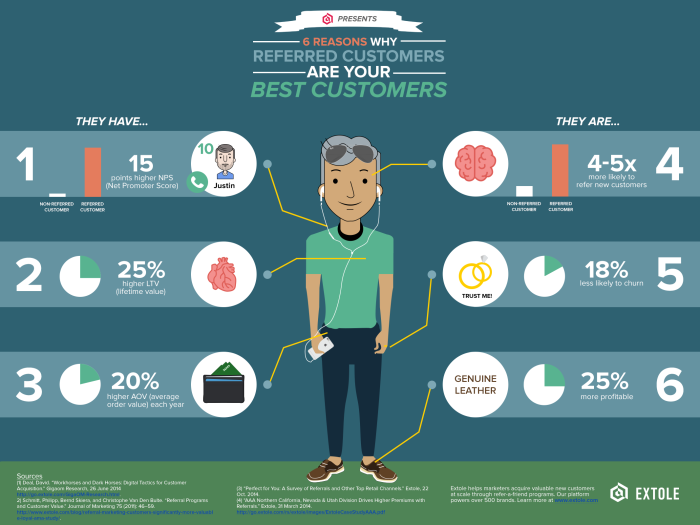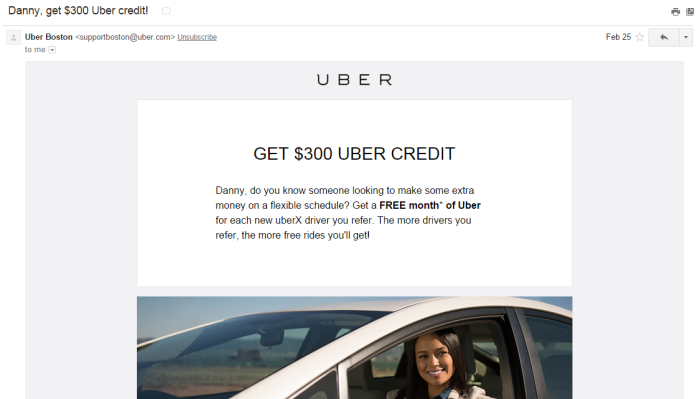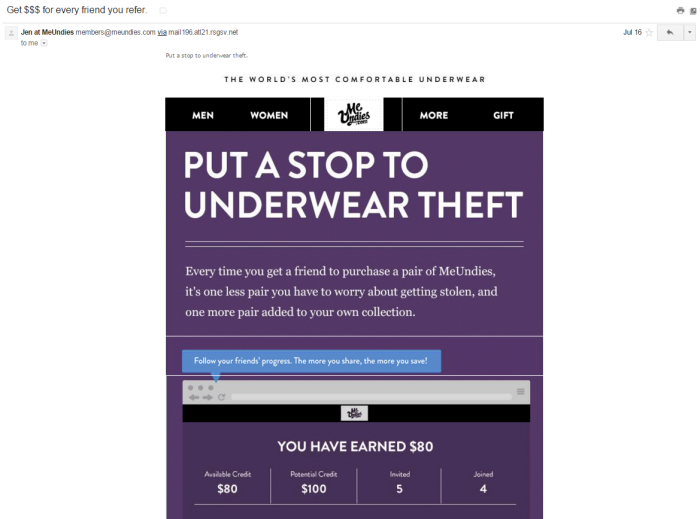The Importance of a Generous Referral Program (plus 12 Clever Strategies to Prompt More Referrals)
Consumers are easily influenced by their peers. In fact, a 2012 survey from Nielsen suggests, “92% of consumers around the world say they trust earned media, such as word-of-mouth and recommendations from friends and family, above all other forms of advertising.”
For businesses, word-of-mouth is the cheapest and most effective way to generate sales. Furthermore, customers referred to a brand tend to be more likely to purchase, less thrifty and more loyal than customers acquired through other marketing channels. Research from referral marketing platform Extole reveals six reasons why referred customers are the best:
- On average, their Net Promoter Score is 15 points higher than non-referred customers.
- They have a 25% lifetime value than their non-referred peers.
- Referred customers have 20% higher annual average order values.
- They are four to five times more likely to refer new customers.
- Referred shoppers are more loyal than non-referred customers and are 18% less likely to churn.
- They are 25% more profitable than other buyers.
Ecommerce brands like Bonobos, Greats and True & Co have all benefitted from customers who were happy to refer their friends (and earn credit towards their next purchase). You, too, can harness the power of customer referrals to grow sales and boost your bottom line.
Developing a profitable referral program
For store owners eager to launch their first referral program, here are five steps.
- Deliver an awesome product and an outstanding customer experience. Satisfied customers already tell their friends about your service; make it easy for them to share special offers that turn conversations about your brand into conversions.
- Segment your buyers and issue unique offers. Create an exclusive referral program for your biggest spenders and your most influential customers on social media. Avoid asking for referrals from customers who frequently complain about your product or the customer service experience.
- Promote your referral program. Prompt customers to refer their friends and family members using a simple form on your website, publicly on social media or privately through email.
- Establish the right incentives. One-sided rewards work best for customers who are happy to share something with their friends without expecting anything in return. Double-sided incentives earn the sender of the referral a reward when people in their network complete a purchase. Also, customers can be rewarded with a discount, freebie or donation to a charity of their choosing.
- Automate the referral process. Using Follow-Up emails and loyalty program apps, stores can remind customers about their referral program and make it painless to refer a friend.
Driving high-quality referrals
Of course, one of the biggest struggles brands have is in getting customers to actually refer someone they know. A couple common reservations are:
- Not knowing who to refer.
- Not wanting to spam their friends and family members.
To help customers brainstorm contacts to refer and feel comfortable with the referral process, fashion companies can copy these lines:
- “Who are five of your most fashionable friends who would love to get this gift for free?” OR
- “Give a free gift to five of your most stylish friends and get a special delivery from us.”
This narrows down the type of customer you want and encourages referrers to filter their contact list to find recipients who would actually value the offer from your referral program. Similarly, food stores can say:
- “Which of your friends has a real sweet tooth? Give them $25 off their first purchase with us.” OR
- “Give $25 worth of snacks to friends who love delicious, organic treats, and we will ship you an extra box when they redeem their offer.”
By tweaking the language that you use to help customers find the right people to refer and to frame the referral offer as a win-win for everyone involved, brands are able to drive high-quality referrals that convert into lifelong customers who spend more than their peers and tell their friends too.
Bonus: Getting every happy customer to refer a friend
Some marketing initiatives require a soft touch to convert audiences into customers. Others demand a more aggressive strategy before shoppers listen and take action. Referral programs fall into the latter category as getting customers to go out of their way to help you grow sales — even with generous incentives — is hard.
The beauty of a successful referral program is it creates value for everyone involved including the referrer (who is usually rewarded for each successful referral), the recipient (who gets a free product to try), and the brand (who gains access to a whole new customer base). With enough customers referring their friends, family and acquaintances, businesses can multiply their sales in a matter of months.
But in order to get all of your happy customers to participate in your referral program, they need to be reminded about the rewards that await them if the referrals they send lead to new sign-ups or sales. Here are 12 clever ways to promote your referral program:
- Account dashboards. When a customer logs into their account, prompt them to share their referral code with a select group of friends. If he was planning on making another purchase soon, he may feel motivated to find friends who might buy from your brand anyways so he can save money on his next order.
- Customer service recaps. After successfully resolving a customer support ticket, share your referral program with satisfied customers. As a thanks, many shoppers may tell their friends about how you effectively and efficiently attended to their latest customer service request.
- Email signature. To subtly remind users about your referral program, include it in every customer-facing employee’s email signature. Add a link that takes them straight to your referral page.
- Email receipts. For shoppers, it is pretty exciting to buy something online. Use order confirmation emails and digital receipts as an opportunity to extend additional value by promoting your referral program.
- Follow-Up emails. Set emails to send automatically after a customer has received his or her package. In these Follow-Up messages, gauge how happy customers are with their purchase and ask satisfied shoppers to refer a friend.
- Homepage banner ads or pop-ups. When customers revisit your site, include a banner ad or pop-up that prompts them to refer their friends.
- Product pages. Sometimes products remind customers of people they know. On every product page, include the option to share a direct link with a friend who may actually want to purchase that product.
- Purchase confirmation and thank you pages. As soon as someone completes an order, hit them with a request to refer people they know who may also enjoy your brand’s products and services. Some brands even use this page to offer partial refunds on a purchase for every successful referral.
- Rewards summaries. Most customer loyalty programs offer good — but not great — rewards. After spending $500 over six months, shoppers might only be able to redeem a $25 credit towards their next purchase. But through your referral program, customers can earn $100 in a matter of minutes if they successfully refer a few friends who end up buying your products and services.
- Retargeting ads. Use retargeting to promote your referral program to paying customers off-site. While they are browsing the web or checking Facebook, you can deliver ads that encourage them to earn credits, discounts or freebies by giving a special offer to a friend.
- Snail mail. Despite our general hate for the post office, many of us actually like receiving physical mail. Send your customers a neat postcard they can forward to friends for free (with postage included) which includes instructions recipients can follow to redeem their referral offer.
- Social media bios. A passive way to get customers to refer others is by updating your social media bios with a reminder about your referral program. This is an easy, non-intrusive way of getting shoppers to refer their friends instead of constantly tweeting out information about your referral program.
Referral marketing is one of the most rewarding ways to leverage the influence and reach of your customers. Stores that discover the perfect strategy for driving customer referrals will always have a constant flow of new business as first-time buyers tell five friends who, in turn, each tell five of their friends about your brand.
By creating win-win scenarios for referrers and recipients, brands have the opportunity to deliver happiness to tons of new customers and grow their business.
How have you applied referral marketing to your business?



